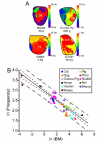Rotors and the dynamics of cardiac fibrillation
- PMID: 23449547
- PMCID: PMC3650644
- DOI: 10.1161/CIRCRESAHA.111.300158
Rotors and the dynamics of cardiac fibrillation
Abstract
The objective of this article is to present a broad review of the role of cardiac electric rotors and their accompanying spiral waves in the mechanism of cardiac fibrillation. At the outset, we present a brief historical overview regarding reentry and then discuss the basic concepts and terminologies pertaining to rotors and their initiation. Thereafter, the intrinsic properties of rotors and spiral waves, including phase singularities, wavefront curvature, and dominant frequency maps, are discussed. The implications of rotor dynamics for the spatiotemporal organization of fibrillation, independent of the species being studied, are described next. The knowledge gained regarding the role of cardiac structure in the initiation or maintenance of rotors and the ionic bases of spiral waves in the past 2 decades, as well as the significance for drug therapy, is reviewed subsequently. We conclude by examining recent evidence suggesting that rotors are critical in sustaining both atrial and ventricular fibrillation in the human heart and its implications for treatment with radiofrequency ablation.
Figures








References
-
- Mayer A. Rhythmical Pulsation in Scyphomedusae. Carnegie Institute of Washington; Washington, DC: 1906. pp. 1–62. Publication number 47.
-
- Mines G. On circulating excitations in heart muscles and their possible relation to tachycardia and fibrillation. Trans R Soc Can. 1914;4:43–52.
-
- Garrey W. The nature of fibrillary contraction of the heart: its relation to tissue mass and form. Am J Physiol. 1914;33:397–414.
Publication types
MeSH terms
Grants and funding
LinkOut - more resources
Full Text Sources
Other Literature Sources
Medical
Miscellaneous

